What is Sleep Apnea?
Sleep apnea currently affects about 20 million people every night here in the U.S. alone, making it the second most prominent sleep disorder in the country (behind insomnia). Rates of sleep apnea are steadily growing every single year, and researchers believe this is due to an increasingly sedentary lifestyle that leads to higher rates of obesity (which is a prominent risk factor for sleep apnea).
When a person has sleep apnea, they frequently stop breathing for brief periods of time as they sleep. When this happens, the body immediately goes into panic mode and partially wakes up in order to restore normal breathing. This can occur 20, 50, or even 100 times an hour without a person even realizing it! In the end, this prevents a person from completing an entire sleep cycle, which means they don’t get the deep, restful sleep they need to stay awake and feel focused the next day.
There are actually two distinct types of sleep apnea. Obstructive sleep apnea (OSA) is by far the most common, and it occurs when the soft tissues in the mouth and throat relax into and block the airway during sleep. This is often predicated by loud, persistent snoring.
The other, less common type is called central sleep apnea (CSA), and this is a neurological issue where the brain simply stops sending the body the signal to breathe while asleep. It’s also possible for a person to have both kinds of sleep apnea at once, though this is quite rare.
The most common symptoms and warning signs of sleep apnea include:
- Loud, chronic snoring
- Gasping for air or waking up feeling out of breath
- Morning headaches
- Sore throat or dry mouth in the morning
- Severe daytime fatigue despite the number of hours slept
- Difficulty focusing or remembering things
- Mood swings and other changes in behavior
- Sexual dysfunction
- High blood pressure
Diagnosing Sleep Apnea
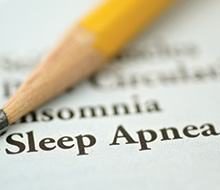
In reality, it can actually be quite difficult to know if you have sleep apnea or not because the most telling symptoms—short cessations of breathing—occur while you are completely asleep. In most cases, it’s actually a bed partner that initially notices a person may have sleep apnea.
The first step to getting treatment for this condition is to get a proper diagnosis, and our team is ready to walk you through this process step by step. The easiest way to get started is to take our short Epworth Sleepiness Scale assessment. It’s only 8 yes or no questions, and it will give Dr. Buck important information as to your probability of having a sleeping disorder. After completing it, we’ll contact you to schedule a consultation with Dr. Buck, and from there, he can recommend you to a local sleep doctor who will perform a sleep study.
A sleep study is a very common medical test that is used to monitor your vital signs while you sleep, and it enables a sleep doctor to definitively determine whether or not you have sleep apnea. You can have the study performed either at home or in a sleep lab, and afterward, the doctor will recommend the appropriate treatment. If they believe that you would benefit from oral appliance therapy, you’ll then return to The Columbus Sleep Center where Dr. Buck will design and fit you for an appliance.
12 Important Facts About Sleep Apnea & Sleep Disorders
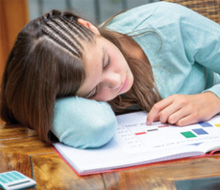
1. Healthy adults should only need about 7-9 hours of sleep a night to feel fully rested and not develop fatigue during the day.
2. Sleep apnea patients often have persistent problems with their weight due to being too tired to exercise.
3. Chronic sleep deprivation can affect the brain just like alcoholism, drug addiction, and even Alzheimer’s.
4. Sleep apnea is frequently self-misdiagnosed as insomnia because it can cause a person to wake up multiple times during the night and/or sleep very lightly.
5. People who snore but do not have sleep apnea have a higher chance of developing it in the future than those who do not snore. Fortunately, this can be effectively prevented using oral appliance therapy.
6. Driving while fatigued is just as dangerous as driving while drunk! In a closed course test, tired drivers were 15x MORE likely to get into an accident than ones who were sober and adequately rested.
7. Most of the people with sleep apnea (80%) are either undiagnosed or misdiagnosed. Furthermore, the majority of those who are diagnosed with sleep apnea never seek out treatment.
8. People with untreated sleep apnea tend to have a much shorter life expectancy, only averaging the age of 55.
9. Sleep apnea is one of the biggest and most unrecognized causes of sexual and erectile dysfunction.
10. People who frequently wake up to urinate during the night might actually be waking up due to sleep apnea.
11. Many people who suffer from bruxism, or unconscious nighttime teeth grinding, may also be suffering from sleep apnea.
12. A larger than average tongue or neck can also be big risk factors for sleep apnea.
Don’t Ignore Snoring
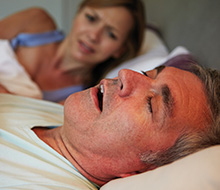
To most people, snoring is simply thought of as an unconscious, if annoying, habit. However, snoring can also indicate serious issues with a person’s sleep. The sound that we’re all familiar with is actually created by air vibrating the tissues in the mouth and throat as it passes by, and this happens because those tissues are partially blocking the airway. For many people, snoring is a precursor to sleep apnea.
Whether a person has sleep apnea or not, snoring reveals that they are not breathing normally during the night, and this prevents them from getting the best quality sleep possible. Fortunately, oral appliance therapy can be used to help those patients who snore and may be at risk of developing sleep apnea in the future.
Your CPAP Alternative
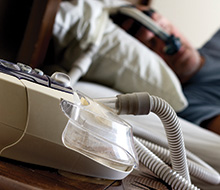
Continuous positive airway pressure (CPAP) therapy is currently the most often prescribed treatment for sleep apnea in America and around the world. It works by having a patient wear a facial mask to bed that is connected via a hose to an air pump that literally forces oxygen into the throat in order to keep it open while a person sleeps. As you can imagine, many find this extremely uncomfortable.
The mask can feel very constrictive, leading many patients to experience feelings of claustrophobia. Also, the machine itself can create quite a bit of noise, which can be disturbing not only to the wearer, but anyone who sleeps near them as well. CPAP machines are also quite bulky, which can limit a patient’s movement while they are trying to fall asleep. This also makes them practically impossible to travel with.
However, at The Columbus Sleep Center, a patient can now benefit from an alternative treatment that easily solves all of these problems—oral appliance therapy. With it, all a patient has to do is wear a small, custom-made mouthguard to bed each night to sleep symptom-free.
These appliances work by gently shifting the jaw forward in order to prevent the tissues in the mouth and throat from obstructing the airway. It’s primarily used to treat patients with mild to moderate sleep apnea, but it can also be used in conjunction with a CPAP for combined therapy. The appliances are small, portable, and very easy to use, making them the most patient-friendly sleep apnea treatment available today.
Does Insurance Cover Sleep Apnea Treatment?
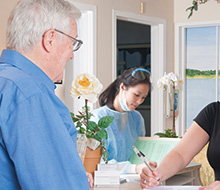
In general, yes, but things can get quite complicated very quickly.
Sleep apnea treatment using oral appliance therapy is typically not covered by dental insurance plans despite the fact that the treatment itself is provided by a dentist. However, it is usually covered by medical insurance and Medicare, and this can all make it really confusing for a patient to know how they are covered. To make things even more complicated, more and more dental insurance plans are starting to cover oral appliance therapy as well.
Fortunately, this is where our team of insurance experts can help. When you get oral appliance therapy from The Columbus Sleep Center, we’ll help you find the best way to maximize your insurance benefits, no matter where they come from. We’ll file the claim, deal with the paperwork, and help walk you through the process to make saving on your care nice and simple.
Sleep Screenings with Pulsox
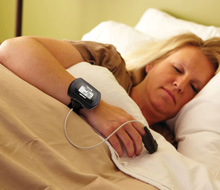
Being able to monitor your heartrate and blood pressure while you sleep is very important to helping you get a proper diagnosis for sleep apnea. Instead of sending you to a lab to have a sleep study done, we can use a small device called a Pulsox so you can do one at home. It fits over your wrist and forefinger (similar to a watch) in order to monitor your pulse while you sleep. It will automatically note any extended periods of elevation that could point to sleep apnea. It can also reveal the signs of other health problems brought on by sleep issues.
We understand that this is a lot of information to process, but here is the one big thing you should remember: if you’ve been having persistent sleep issues, or if you just can’t seem to get enough rest, you should contact The Columbus Sleep Center. We can help you discover the cause of your problems and then provide the solution you need.
If you have any questions, or if you would like to schedule a consultation, please contact us today.
